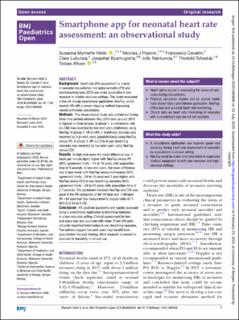| dc.contributor.author | Höök, Susanna Myrnerts | |
| dc.contributor.author | Pejovic, Nicolas | |
| dc.contributor.author | Cavallin, Francesco | |
| dc.contributor.author | Lubulwa, Clare | |
| dc.contributor.author | Byamugisha, Josaphat | |
| dc.contributor.author | Nankunda, Jolly Kaharuza | |
| dc.contributor.author | Tylleskär, Thorkild | |
| dc.contributor.author | Alfven, Tobias | |
| dc.date.accessioned | 2021-04-30T07:55:50Z | |
| dc.date.available | 2021-04-30T07:55:50Z | |
| dc.date.created | 2021-02-23T13:52:02Z | |
| dc.date.issued | 2020 | |
| dc.identifier.issn | 2399-9772 | |
| dc.identifier.uri | https://hdl.handle.net/11250/2740485 | |
| dc.description.abstract | Background: Heart rate (HR) assessment is crucial in neonatal resuscitation, but pulse oximetry (PO) and electrocardiography (ECG) are rarely accessible in low-resource to middle-resource settings. This study evaluated a free-of-charge smartphone application, NeoTap, which records HR with a screen-tapping method bypassing mental arithmetic calculations.
Methods: This observational study was carried out during three time periods between May 2015 and January 2019 in Uganda in three phases. In phase 1, a metronome rate (n=180) was recorded by low-end users (midwives) using NeoTap. In phase 2, HR (n=69) in breathing neonates was recorded by high-end users (paediatricians) using NeoTap versus PO. In phase 3, HR (n=235) in non-breathing neonates was recorded by low-end users using NeoTap versus ECG.
Results: In high-end users the mean difference was 3 beats per minute (bpm) higher with NeoTap versus PO (95% agreement limits −14 to 19 bpm), with acquisition time of 5 seconds. In low-end users, the mean difference was 6 bpm lower with NeoTap versus metronome (95% agreement limits −26 to 14 bpm) and 3 bpm higher with NeoTap versus ECG in non-breathing neonates (95% agreement limits −48 to 53 bpm), with acquisition time of 2.7 seconds. The agreement between NeoTap and ECG was good in the HR categories of 60–99 bpm and ≥100 bpm; HR <60 bpm had few measurements (kappa index 0.71, 95% CI 0.63 to 0.79).
Conclusion: HR could be accurately and rapidly assessed using a smartphone application in breathing neonates in a low-resource setting. Clinical assessment by low-end users was less accurate with wider CI but still adds clinically important information in non-breathing neonates. The authors suggest low-end users may benefit from auscultation-focused training. More research is needed to evaluate its feasibility in clinical use. | en_US |
| dc.language.iso | eng | en_US |
| dc.publisher | BMJ | en_US |
| dc.rights | Navngivelse-Ikkekommersiell 4.0 Internasjonal | * |
| dc.rights.uri | http://creativecommons.org/licenses/by-nc/4.0/deed.no | * |
| dc.title | Smartphone app for neonatal heart rate assessment: an observational study | en_US |
| dc.type | Journal article | en_US |
| dc.type | Peer reviewed | en_US |
| dc.description.version | publishedVersion | en_US |
| dc.rights.holder | Copyright the authors 2020. | en_US |
| dc.source.articlenumber | e000688 | en_US |
| cristin.ispublished | true | |
| cristin.fulltext | original | |
| cristin.qualitycode | 1 | |
| dc.identifier.doi | 10.1136/bmjpo-2020-000688 | |
| dc.identifier.cristin | 1892759 | |
| dc.source.journal | BMJ Paediatrics Open | en_US |
| dc.relation.project | Norges forskningsråd: 223269 | en_US |
| dc.identifier.citation | BMJ Paediatrics Open. 2020, 4 (1), e000688. | en_US |
| dc.source.volume | 4 | en_US |
| dc.source.issue | 1 | en_US |

